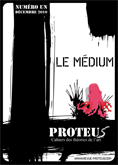Regards croisés sur le Principe d’équivalence de Robert Filliou — Une oeuvre hors-médium
Abstract
 Télécharger l’article
Télécharger l’article
Paru dans : Proteus n°1

Cet article se propose d’examiner le Principe d’équivalence (« Bien fait, mal fait, pas fait ») de Robert Filliou comme un œuvre d’art. À ce titre, l’immatérialité relative de cette proposition d’abord textuelle pose un problème esthétique qui ne peut être résolu qu’à la condition de penser le divorce de l’art et de son médium — entendu au sens de support d’expression. Une telle rupture tendrait à ouvrir le dialogue avec l’art conceptuel, un art tourné vers ses propres conditions de possibilités et prêtant au support une valeur secondaire. Mais il apparaîtra que c’est un tout autre rapport au medium qui se joue avec le Principe, dans la mesure où c’est sa nullité même qui en garantit la lecture comme un geste créatif plutôt que comme un objet d’art. En somme, c’est une œuvre « hors-médium ». Ce n’est qu’une fois supprimé notre rapport à l’objet esthétique comme seul horizon de l’art que l’on peut penser toute pratique créative comme un continuum entre l’art et la vie. En cela le Principe d’équivalence se pose comme la proposition axiomatique de la Création Permanente théorisée par Filliou.
Mots-clés : qualités esthétiques — geste — art conceptuel — matériau — bien fait/mal fait/pas fait
This papers examines Robert Filliou’s Principle of equivalence (“Well done, not done, poorly done”) as a work of art. To that extent, the relative immateriality of this mainly textual proposition poses an aesthetic problem that can only be resolved by thinking the divorce of art from its medium — thought as a support for expression. Such rupture would tend to instigate dialog with conceptual art, an art devoted to its own conditions of possibility and according to the support a secondary value. But it appears that a whole different relationship to the medium that is at work in the Principle, in that its nullity itself guarantees the reading as a creative gesture instead as an art object. In short, this work is “beyond-medium”. Only when suppressed our relationship to the aesthetic object as only horizon for art, can we think every creative activity in a continuum between art and life. The Principle of equivalence hence presents itself as the axiomatic proposition of the Permanent Creation theorised by Filliou.
Keywords : aesthetic qualities — action — conceptual art — material — well made/ill made/not made








